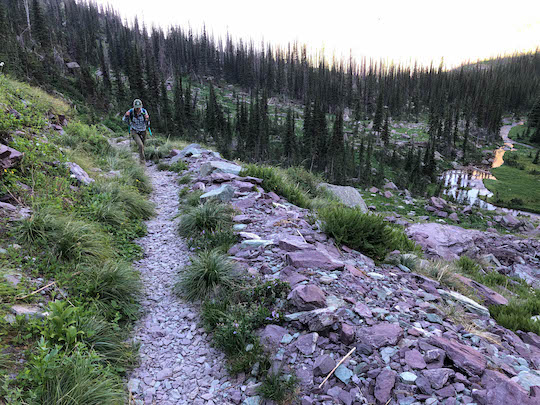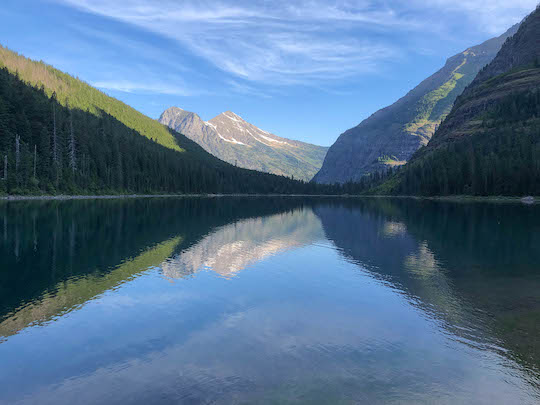After we had a nice lunch break on our Sperry Glacier hike, it was time to hit the trail again. We still needed to climb a bit higher to get to Comeau Pass and Sperry Glacier beyond. The daylight would get away from us if we didn't keep moving. Not only did we need to still reach the glacier, we also had a long return hike ahead of us.
As we were wrapping up lunch, I noticed a large clump of flowers overlooking Akaiyan Lake. Since I had my pack open already for lunch, it was easy to grab my camera and take a picture. As with many of the other flowers I encountered in Glacier National Park, I'm still having a hard time with identification. That said, I believe this one is rocky ledge penstemon. If anyone has any better identification, please let me know!
The next wildflower was one I recognized without the need for an identification guide. Spring beauty is a wildflower we have here in Tennessee. In fact, I even have them in my yard. They are one of the earliest wildflowers in the spring around here, so I was surprised to find them still blooming at the end of July here in Glacier National Park. Of course, with the huge snow fields everywhere and a large glacier lurking just over the pass, the wildflowers probably still thought it was early spring.
Shortly above our lunch stop, the trail reached yet another bench that followed the headwall above Akaiyan Lake towards the base of Gunsight Mountain. At the far end of the bench, the trail turned and started a series of switchbacks up to Comeau Pass. We were getting close.
At this point, both of us had our cameras out. The scenery was the same that we had enjoyed during lunch, but the perspective was constantly shifting as we moved along. Our cameras were kept busy with the occasional wildlife as well. We both enjoy the marmots, ground squirrels, and other critters. My wife stalked a marmot while I found a willing golden mantled grand squirrel.
Oh, and we didn't forget to photograph the views either.
Speaking of wildlife, if you haven't read about the mountain goat, go back and do so now. This was one of the hiking highlights of Glacier National Park for both of us but especially for my wife. Here is a teaser picture of the goat along with the story.
The Goat on the Trail to Sperry Glacier
After the mountain goat encounter, we were excited for the final push up to Comeau Pass and Sperry Glacier beyond. The trail finally turned and made a beeline to a gash in the final headwall below the pass. This passage has been vastly improved by the park service with some stairs cut into the rock to make climbing easier. It is a little sketchy, but overall not a bad final climb to breathtaking Comeau Pass. When we got to the top, the views were incredible. The Sperry Glacier was lurking out of sight, however. With a bit of research, I found this interesting comparison of what it looked like back in the 1930s with today. Unfortunately, Sperry Glacier has retreated a LOT since then.
Here is the view towards Sperry Glacier from Comeau Pass. Note the mountain goat in the lower left side of the first picture. This mountain goat came up the stairs just after we did and continued on across the landscape. The bulk of Gunsight Mountain is just out of view to the right.
After gaining the pass and pausing for a few pictures, we pushed on towards Sperry Glacier itself. This was our main objective after all. The trail crossed rocks and many large snowfields. We had to be a bit careful on some of the snow bridges. Streams were running underneath and we didn't want to have one collapse and dump us into the icy water. All of this water was rushing downhill towards Avalanche Lake for the most part.
Finally, after what seemed much farther than we anticipated, Sperry Glacier finally came into view. We simply stood still and took it all in before remembering to snap a few pictures as well. We felt incredibly fortunate to be able to experience this place while a glacier is still present. At the rate things are going, this opportunity won't last long so see it soon while you can.
We were getting low on water at this point and decided to filter some water from the glacial runoff before heading too far back towards Comeau Pass and the trail downhill. As we were heading that general direction, we had a couple more awesome wildlife encounters. The first happened as I came over a jumbled pile of boulders and stepped down. Out on the white snow, something moved. I quickly froze and realized I had almost run over a ptarmigan. Since I love birds, this was a big treat. I'm not a hard core birder, but I do enjoy seeing new to me species. This was one that I hadn't found when I lived in Colorado or on any other trips out west. I quickly switched out lenses on my camera and thankfully the bird didn't run off too fast. Here are a couple of pictures.
The second encounter was better for my wife. We saw a good sized group of mountain goats resting on the snowfields below Gunsight Mountain. My wife decided to move in for a closer look and better pictures. I'll share her post so you can see her pictures if and when she gets around to it, but the neat thing about this group is that it had a big billy goat. When I say big, he made all the other goats look small.
After these two wildlife encounters, we decided it was time to make haste. According to my wife's watch, we were over 10 miles for the day and still had nearly that to get back to the car. Our extra wandering around to see things was adding up to a big day.
On the trail down, we got serious about walking. Both of us put our cameras up and got our trekking poles back out. The trekking poles are really useful for when you have big elevation changes up or down. On the downhill, they really take a lot of the pressure off of your knees. This was what I had brought them for. I can do uphill although on this day I had struggled a bit with the heavy cardio. The downhill usually gets my knees aching, though, and we had a lot of trip left. I didn't want to get gimpy now!
Back down the trail a ways, we ran into some more mountain goats. These things are everywhere but it takes at least some luck to cross paths with them. These were pawing and eating at the trail itself. Apparently, the goats like to eat the minerals and salts from where people urinate. Yep, the goats eat pee or at least the remnants of it. This is a really good reason to do your business on durable surfaces. There were huge gaping holes in the trail where the goats had pawed and otherwise dug into the trail to get at the minerals. Regardless of why they were there, the goats did offer some good photo opportunities and we dug our cameras back out.
After this, the wildflowers were distracting, but I was getting tired enough that I didn't bother to photograph any until we stopped for water. At that point, there was a clump of some of my favorites, the purple monkey flowers. I snapped a picture, filtered water, and then we kept trucking on down the long trail back.
From that break on, we really made haste. The miles flew by on increasingly tired feet. We were both starting to look forward to the end of the hike, something that doesn't happen too often. Thankfully, nature had one more surprise to perk us up. We were on the steep downhill section just above Lake McDonald. As we came around one switchback, we noticed a deer. Seriously, normally we wouldn't be too excited about deer, but we hadn't been seeing tons of larger wildlife on this trip. This was another photo opportunity that couldn't be missed. This curious buck was not worried about us in the least.
After this picture, we quickly finished our hike and were back to the car ready to go back to camp and rest. According to my wife's watch, including our small side trips for different things, we had put in a little over 20 miles. This was a new record for each of us. We have been close but never broke 20 miles in the Smokies. We were tired but also very satisfied from a day well spent in the most glorious surroundings.
In many ways, day five was the pinnacle of our trip to Glacier National Park. This was our longest hike for the trip and also one of my favorites. The only hike that came close was our last day in Glacier, but I'll save that for another day.

































































